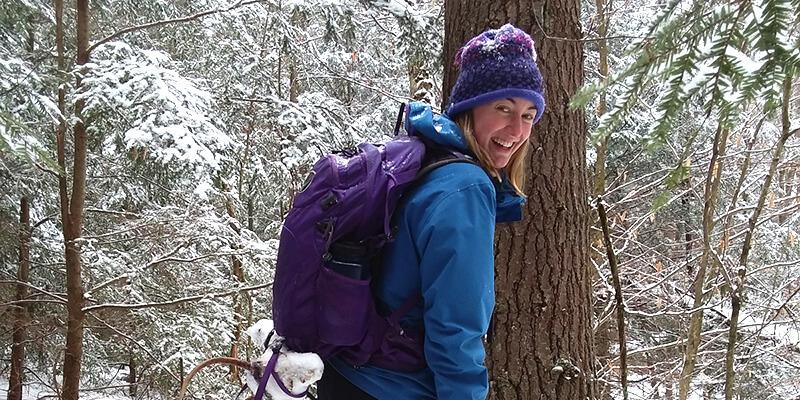Diana Gurvich ’18 collected insects and spiders as a child growing up outside of Boston. As a high school student, she discovered birding and a whole community of birders. She enrolled in the University of Vermont’s Rubenstein School of Environment and Natural Resources, her first-choice school, as a wildlife and fisheries biology major.
Fall semester sophomore year, a Dendrology course introduced her to identification and study of trees, which changed the direction of her career plans.
“Knowledge of trees and forest habitats is also important for work in wildlife biology and management,” said Diana, who is considering ideas for graduate school studies that range from forest and bird interactions, ecology, and entomology to environmental education or even art. “I am definitely interested in the ecology and education side of the forestry field.”
With her passion turned to trees, she switched her major to forestry. When she took a Silviculture course with Professor Tony D’Amato, director of the forestry program, Diana knew she had settled into the right major.
“Tony has been wonderful at building a strong sense of community. The forestry program is a tight-knit group because we all take courses together, including an intensive three-week forestry summer field camp, and are active in the student chapter of the Society of American Foresters [SAF],” said Diana, who served as president and treasurer of the club. Twice, she helped the UVM Rubenstein School 4-student team win the college quiz bowl at the New England SAF annual meeting. For her leadership and achievements, she was honored with the SAF Green Mountain Division James E. Wilkinson Jr. Student Award.
An artist, Diana designed graphics for Tony’s annual Forester’s Day event flyers and buttons. Through her love for dendrology, she developed an eye for drawing detailed depictions of tree twigs and buds.
To foster her longtime interest in insects, Diana took an introductory course called A Bug’s Life in UVM’s Plant and Soil Science Department. As a research intern with Associate Research Professor Kimberly Wallin and graduate student Sarah Pears, Diana learned to pin collected insects. She identified and organized a 240-specimen beetle collection to assess insect biodiversity response to a windstorm-damaged forest ecosystem.
Her pinning skills came in handy when she took a Field Zoology course with Associate Professor Ingi Agnarsson of the UVM Biology Department. The course required Diana to submit her own collection of 70 insects identified to at least family level.
Her growing experience in all things entomological led to a job at UVM’s Thompson Zoological Collection, where she spent nearly two years organizing and digitizing Vermont’s oldest and largest collection of more than 600,000 insects. As an assistant curator technician, she trained and supervised volunteers to help with the collection. Awarded the Dale Bergdahl Scholarship in honor of a former professor who studied forest pathology and entomology, Diana graduates with a concentration in entomology, as well as a minor in geospatial technologies.
During the summer and fall of her sophomore year, Diana interned with the Forest Ecosystem Monitoring Cooperative (FEMC) in Burlington, Vermont. As part of a field crew, she traveled throughout Vermont and collected forest health monitoring data on forest plots. Tapping into her captivation with birds, she collected and analyzed links between bird biodiversity and habitat data from the plots as an independent project. She presented her findings at the annual FEMC conference.
Her next internship took her farther afield. As a field ecology intern with Nature’s Capital, LLC, an ecological assessment firm out of Boise, Idaho that contracts with the U.S. Forest Service and Bureau of Land Management (BLM), Diana spent the summer of her junior year trekking the backcountry of northern Idaho. As part of a field team, she collected long-term forest monitoring data, identified and measured trees, and took tree cores for aging. She also helped survey whitebark pine for white pine blister rust disease and co-authored a report submitted to the BLM.
An enthusiasm for environmental education enticed Diana to become a teaching assistant in several Rubenstein School courses. In NR 1 Natural History and Field Ecology, she helped introduce incoming first-year students to topics and field exercises in landscape ecology, land use history, geology, forestry, and more. For an Applied Environmental Statistics course, she assisted students and graded assignments.
But her ultimate accomplishment was serving as a teaching assistant for Dendrology, her favorite class.
“I knew I wanted to TA Dendro ever since I took the course,” said Diana, who taught a weekly field lab section in the fall. “It was rewarding to see other undergraduates find out how cool dendro is and come out of the class with all that tree knowledge like I did. Being able to pass on what I had learned helped me to get even better at tree ID.”
Recipient of the forestry program’s Luther E. Zai Memorial Award and a Xi Sigma Pi forestry honor society regional scholarship for the entire Northeast, Diana graduates in May. And, she found a position that fulfills many of her interests.
She will work as a forest ecology technician at the Schoodic Institute in Winter Harbor, Maine, headquartered in Acadia National Park. For the summer and better part of the fall, she will conduct tree and climate change research to guide management of the Park. She will work with Earthwatch volunteers and assist with public outreach and education. Last but not least, she hopes to interact with an Artist-in-Residence program hosted by the Institute.
